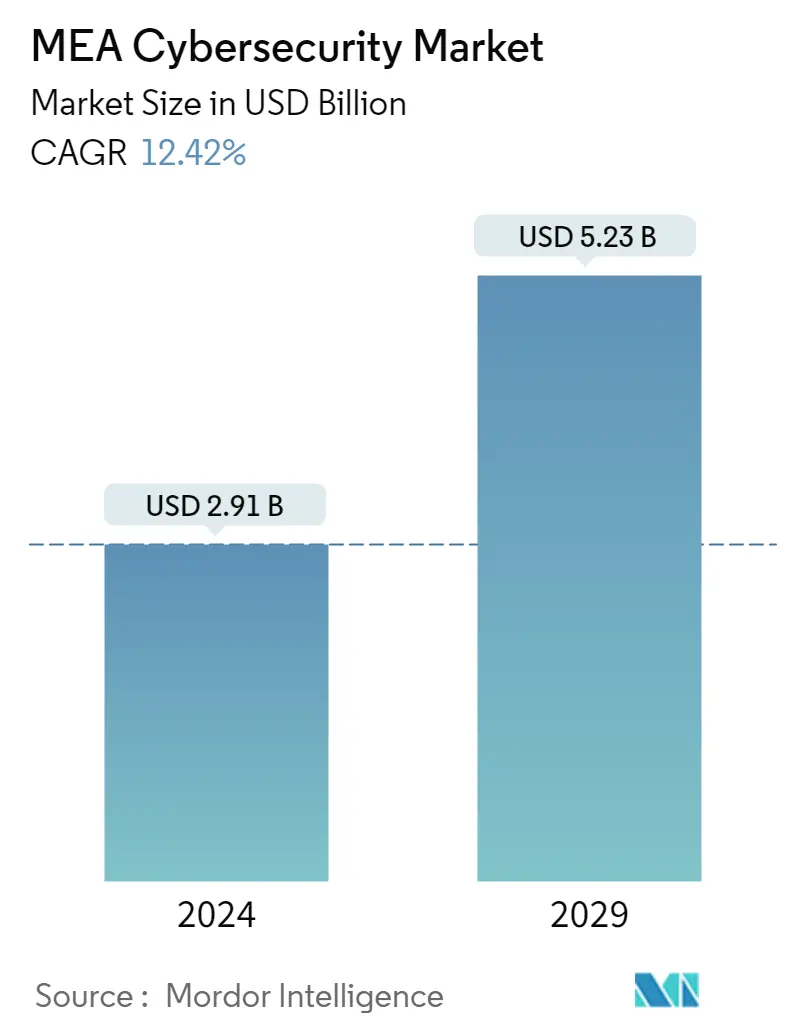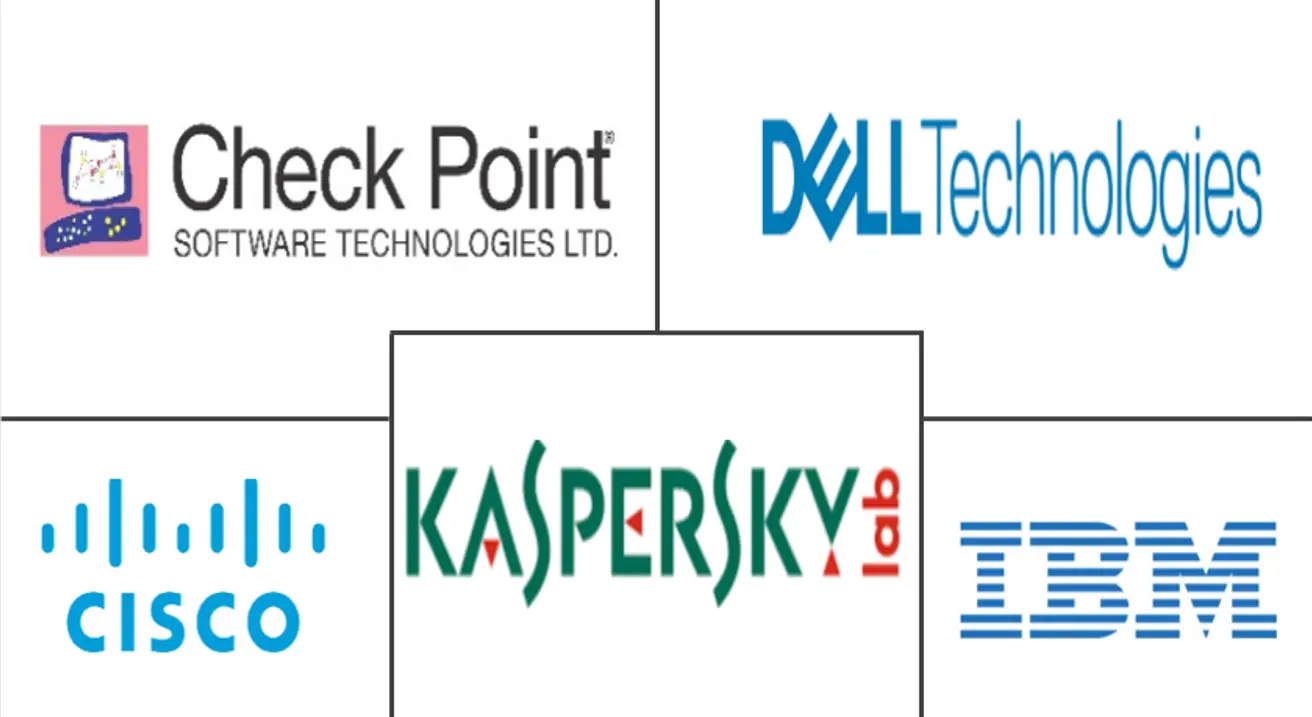Market Size of MEA Cybersecurity Industry

| Study Period | 2019 - 2029 |
| Base Year For Estimation | 2023 |
| Market Size (2024) | USD 2.91 Billion |
| Market Size (2029) | USD 5.23 Billion |
| CAGR (2024 - 2029) | 12.42 % |
| Market Concentration | High |
Major Players
*Disclaimer: Major Players sorted in no particular order |
Middle East & Africa Cybersecurity Market Analysis
The MEA Cybersecurity Market size is estimated at USD 2.91 billion in 2024, and is expected to reach USD 5.23 billion by 2029, growing at a CAGR of 12.42% during the forecast period (2024-2029).
- In the current market scenario, Cybersecurity clusters can grow organically or develop through intentional, often top-down actions taken by local governments, and government regulations and policies play a significant role in their development. Many private firms have been moving their operations to the cloud platform.
- Saudi Arabia, an oil-based economy, is the largest in the Gulf region and aims to be the most prominent IT market. Like the National Transformation Program (NTP), several government initiatives have supported the region's rapid IT development. Saudi Arabia is a popular target for cybercriminals due to its oil wells and occupancy of an area prevalent with geopolitical tensions. Under the NTP initiative, the government outlined SAR 4 billion for ICT development from 2016 until the previous year. The main focus areas are cybersecurity, smart grid, and geospatial IT systems to control significant infrastructure. Such a push from the government provides scope for IT security companies to flourish within the country.
- According to Help AG's State of the Market Report of the previous year, there was a 183% rise in attacks in the UAE alone. All sectors in the nation faced repeated attacks, including the government, oil, healthcare, and telecom. Distributed Denial of Service (ddos) has only increased in scale, according to the company, with the UAE measuring 254.3 Gbps. Further, the growth in the number of smes and cybersecurity vendors in the country is directing focus on offering innovative solutions. Thus, vendors are expected to adopt new launches as part of their competitive strategy. For example, UAE-based Coordinates announced Adaptive Bespoke Cybersecurity for SME.
- To support Qatar's efforts to address the current and emerging threats and risks, and in light of the strategic thrusts of Qatar's National ICT Plan to protect the national critical information infrastructure providing a safe and secure online environment for the different sectors, Qatar National Cyber Security Strategy (NCSS) was created by the National Cyber Security Committee (NCSC). The NCSC was primarily established under the Prime Minister's Decision No. (18) to provide a governance structure for collaboratively addressing cyber security at the highest levels of the government.
- The Middle East & Africa region have smaller numbers of cybersecurity workforces. Still, considering the region's high degree of business activities, it is one of the most attractive regions for cyber attacks. Also, most professionals in this region need to be more experienced in dealing with the intensity of incoming cyber threats. For instance, According to Fircroft, around 30% of all cybersecurity workforce in the Middle East have just over ten years of experience working in the industry. In comparison, 60% of these professionals have more than five years of experience.
- Enterprises adopting remote working during the covid-19 increased the number of attacks. According to IBM, the average cost was USD 1.05 million higher in breaches where remote work was a factor in causing the breach compared to those where remote work was not a factor. According to a study by Proofpoint in 2021 (N=1,400 respondents; Chief Information Security Officers (cisos) from organizations with more than 200 employees), about 76% CISO's from UAE and 69% of CISO's from KSA part of the study mentioned their business had seen more targeted attacks since enabling widespread remote working worldwide in 2021.
Middle East & Africa Cybersecurity Industry Segmentation
Cybersecurity solutions help an organization to monitor, detect, report, and counter cyber threats that are internet-based attempts to damage or disrupt information systems and hack critical information using spyware and malware, and by phishing, to maintain data confidentiality.
The Middle East & Africa Cybersecurity Market is segmented by Solution (Threat Intelligence and Response Management, Identity and Access Management, Data Loss Prevention Management, Security and Vulnerability Management, Unified Threat Management, Enterprise Risk and Compliance), Services (Managed Services, Professional Services), Deployment (Cloud and On-Premise), End-user Industry (Aerospace and Defense, BFSI, Healthcare, Manufacturing, Retail, Government, IT and Telecommunication), and Country (Saudi Arabia, United Arab Emirates, South Africa).
The market sizes and forecasts are provided in terms of value (USD) for all the above segments.
| Solution | |
| Threat Intelligence and Response Management | |
| Identity and Access Management | |
| Data Loss Prevention Management | |
| Security and Vulnerability Management | |
| Unified Threat Management | |
| Enterprise Risk and Compliance |
| Service | |
| Managed Services | |
| Professional Services |
| Deployment | |
| Cloud | |
| On-premise |
| End User | |
| Aerospace and Defense | |
| BFSI | |
| Healthcare | |
| Manufacturing | |
| Retail | |
| Government | |
| IT and Telecommunication | |
| Other End users |
| Country | |
| Saudi Arabia | |
| United Arab Emirates | |
| South Africa | |
| Rest of Middle East and Africa |
MEA Cybersecurity Market Size Summary
The cybersecurity market in the Middle East and Africa is experiencing significant growth, driven by increasing digital transformation and the rising frequency of cyber threats. The region's strategic initiatives, such as Saudi Arabia's National Transformation Program and Qatar's National Cyber Security Strategy, are fostering a conducive environment for cybersecurity advancements. These government-led efforts, alongside the growing adoption of cloud-based managed security services, are propelling the demand for innovative cybersecurity solutions. The UAE, in particular, is witnessing a surge in cyberattacks across various sectors, prompting a focus on advanced cybersecurity measures. Despite the challenges posed by a relatively inexperienced workforce and the need for enhanced cloud security, the region's enterprises are increasingly leveraging cloud technologies to bolster their cybersecurity posture.
The competitive landscape of the cybersecurity market in the Middle East and Africa is characterized by the presence of major players such as Cisco Systems Inc., Dell Technologies, and IBM Corporation, who are actively expanding their market share through strategic collaborations and partnerships. The financial services sector, particularly in the UAE, is rapidly adopting digitalization and cybersecurity measures to combat emerging threats. Initiatives like the UAE Banks Federation's cyber threat data sharing and the National Bank of Fujairah's robust cybersecurity strategy highlight the sector's commitment to enhancing cyber resilience. Additionally, partnerships, such as Mastercard's collaboration with Nigeria-based NowNow, aim to strengthen the cybersecurity ecosystem for SMEs. As the region continues to embrace digital transformation, the demand for comprehensive cybersecurity solutions is expected to grow, offering lucrative opportunities for both local and international players.
MEA Cybersecurity Market Size - Table of Contents
-
1. MARKET DYNAMICS
-
1.1 Market Overview
-
1.2 Market Drivers
-
1.2.1 Rapidly Increasing Cyber Security Incidents
-
1.2.2 Consistent Threats From the Underground Market
-
-
1.3 Market Restraints
-
1.3.1 Lack of Cyber Security Professionals
-
1.3.2 High Reliance on Traditional Authentication Methods and Low Preparedness
-
-
1.4 Industry Attractiveness - Porter's Five Force Analysis
-
1.4.1 Threat of New Entrants
-
1.4.2 Bargaining Power of Buyers/Consumers
-
1.4.3 Bargaining Power of Suppliers
-
1.4.4 Threat of Substitute Products
-
1.4.5 Intensity of Competitive Rivalry
-
-
1.5 Technology Snapshot
-
1.5.1 Security Type
-
1.5.1.1 Network
-
1.5.1.2 Cloud
-
1.5.1.3 Application
-
1.5.1.4 End-point
-
1.5.1.5 Wireless Network
-
1.5.1.6 Other Security Types
-
-
1.5.2 Industry Value Chain Analysis
-
1.5.3 Assessment of Impact of COVID-19 on the Market
-
-
-
2. MARKET SEGMENTATION
-
2.1 Solution
-
2.1.1 Threat Intelligence and Response Management
-
2.1.2 Identity and Access Management
-
2.1.3 Data Loss Prevention Management
-
2.1.4 Security and Vulnerability Management
-
2.1.5 Unified Threat Management
-
2.1.6 Enterprise Risk and Compliance
-
-
2.2 Service
-
2.2.1 Managed Services
-
2.2.2 Professional Services
-
-
2.3 Deployment
-
2.3.1 Cloud
-
2.3.2 On-premise
-
-
2.4 End User
-
2.4.1 Aerospace and Defense
-
2.4.2 BFSI
-
2.4.3 Healthcare
-
2.4.4 Manufacturing
-
2.4.5 Retail
-
2.4.6 Government
-
2.4.7 IT and Telecommunication
-
2.4.8 Other End users
-
-
2.5 Country
-
2.5.1 Saudi Arabia
-
2.5.2 United Arab Emirates
-
2.5.3 South Africa
-
2.5.4 Rest of Middle East and Africa
-
-
MEA Cybersecurity Market Size FAQs
How big is the MEA Cybersecurity Market?
The MEA Cybersecurity Market size is expected to reach USD 2.91 billion in 2024 and grow at a CAGR of 12.42% to reach USD 5.23 billion by 2029.
What is the current MEA Cybersecurity Market size?
In 2024, the MEA Cybersecurity Market size is expected to reach USD 2.91 billion.

